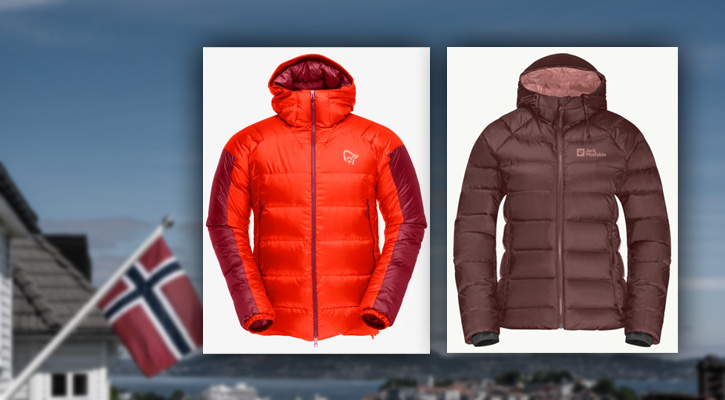
Norrøna and Jack Wolfskin are the brands that we’ll compare today. It’ll be an interesting discussion if you’re in the market for high-quality outdoor gear.
Both have long histories of creating durable and functional products. Norrøna was started in Norway in 1929 and has focused on technical gear for challenging conditions. Jack Wolfskin began in Germany in 1981 and offers a wide range of clothing and equipment.
In this article, we’ll look at their product lines, sustainability efforts, manufacturing processes, and pricing to explore the strengths of each company so we can understand which would be your best choice depending on your particular needs.
Contents:
1. Norrøna Outdoor Gear
History of the Brand
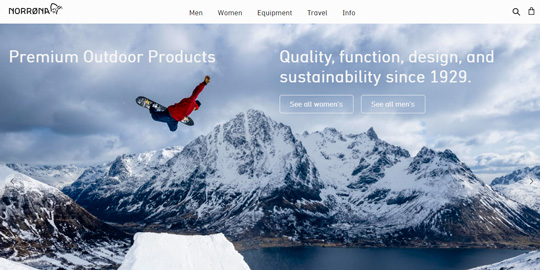
Norrøna official website
In 1929, Norwegian outdoor enthusiast Jørgen Jørgensen began his search for durable outdoor gear suitable for Norway‘s challenging conditions. This event marked the inception of Norrøna as he began crafting simple gear such as leather items, canvas packs, and cotton clothing.
In 1948, Bjarne Jørgensen, the second generation Jørgensen, took the lead of the company. Over the subsequent years, Norrøna broadened its product range and shifted focus to technical gear and mountain equipment.
In 1971, Ole Jørgen Jørgensen, the third generation Jørgensen, took over as manager, and engineer Tomas Carlstrøm was recruited to aid in the development of backpacks and mountain tents. During the 1970s and 1980s, Norrøna gained acclaim for pioneering products and supporting expeditions.
Notable achievements included the introduction of the first tunnel tent in 1972, Europe’s innovative Gore-Tex jacket in 1977, and the provision of gear for the winter ascent of Trollveggen in 1979.
Design became Norrøna’s third cornerstone in 2000, with a focus on Loaded Minimalism philosophy centered on sleek, functional design. The company began its international expansion in the mid-2000s, establishing new collections and outlets in Europe and North America.
In 2015, sustainability was incorporated as Norrøna’s fourth building block, with a commitment to transparency and a pledge to donate 1% of sales to environmental causes.
Presently, four generations later, Norrøna remains a family-owned enterprise headquartered in Norway. Under the leadership of current manager Jørgen Jørgensen, with the same name as the founder, the company persists in pioneering technical outdoor equipment rooted in Norwegian traditions.
Don’t miss:
9 Brands like Norrøna: Our Best Alternatives
Norrøna vs Mammut: Which is Better for Outdoor Gear?
Materials, Fabrics, and Production Process
Norrøna is dedicated to incorporating high-performance, environmentally friendly materials into its product line. They are at the forefront of utilizing sustainable fabrics such as organic cotton, recycled polyester and nylon, and down insulation that adheres to the Responsible Down Standard (RDS).
Additionally, they employ Bluesign-approved fabrics to further their commitment to eco-friendly practices. The company prioritizes transparency and is recognized for its exclusive use of 100% organic cotton and extensive use of recycled polyester.
Norrøna actively participates in various programs like the Fashion for Good organization to promote sustainability. Through their 1% for Nature program, they contribute 1% of annual sales to environmental causes and organizations dedicated to preserving nature.
They strive for complete transparency in their sourcing and manufacturing processes, firmly embedding sustainability into Norrøna’s business ethos. Their technical products demonstrate a dedication to pioneering eco-friendly materials and minimizing environmental impact.
This dual focus on performance and the planet underscores their leadership in sustainable outdoor apparel and gear.
Norrøna, like other famous premium outdoor brands, leverages cutting-edge fabric technologies and materials, including various versions of Gore-Tex membranes, Polartec performance fabrics, and PrimaLoft synthetic insulation.
The natural down insulation originates from the Pyrenees mountains in France, and the treatment of the birds complies with strict European standards.
The video will be loaded from YouTube.com, a third party. If you play it, you accept their terms of service, and their use of cookies.
Read also:
Norrøna vs Patagonia (Outdoor Gear Comparison)
Norrøna vs Arc’teryx Women’s Ski Jackets: Which Brand To Choose?
Where is Norrøna outdoor gear made?
Norrøna’s outdoor equipment is manufactured in various European and Asian facilities. Presently, the company operates production sites in Lithuania, Spain, Portugal, Denmark, and Sweden within Europe, as well as in Vietnam, China, and Thailand in Asia. (source)
Recommended Products
Norrøna trollveggen down 850 Men’s Jacket
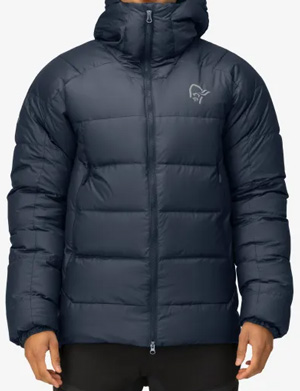
Image: norrona.com
Check it out at Norrona.com
The Norrøna trollveggen down 850 Men’s Jacket stands out as a high-quality mountaineering down jacket crafted with aeroDownproof face fabric and RDS-certified 850+ fill power down, delivering top-notch insulation without adding extra weight.
Notable features include windproof Pertex Quantum 30D 100% recycled polyester fabric, 100g PrimaLoft Gold insulation in the pockets and shoulders, hand warming pockets, an insulating hood, and an extended back for added protection against the cold.
Read also: 10 Norwegian Jackets and Clothing Brands that You’ll Love
Norrøna lyngen 40L Pack
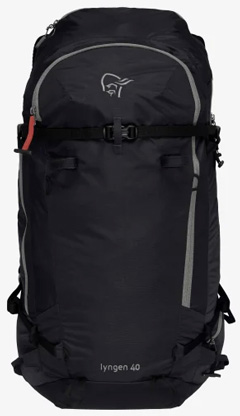
Image: norrona.com
Check it out at Norrona.com
The Norrøna Lyngen 40L Pack is a lightweight and versatile backpack specifically crafted for ski touring, mountaineering, and hiking. Made of durable ECONYL® material using closed-loop regeneration processes, the pack has water-resistant properties and high-quality YKK zippers.
Its design incorporates a highly ventilated back with an open-back construction and includes dedicated compartments for avalanche equipment, a rope, and crampons. The pack is optimized for transporting ski and snowboard gear and features compression straps, a hip belt with a pocket, ice ax attachments, and a chest strap.
The adjustable shoulder straps are engineered with a 3D construction for optimal breathability.
Read also: 3 Best Norwegian Backpack Brands: Our Top Picks
Prices
Norrøna produces long-lasting and comfortable outdoor equipment using materials that can endure tough conditions. Enthusiasts report a sense of being well-supported and capable of achieving peak performance even in the harshest environments due to Norrøna’s engineering.
But the initial investment for all this quality is higher than other brands, with Norrøna’s jackets priced between $300 and $1000, and backpacks ranging from $100 to $700.
Are Norrøna products worth the price?
Norrøna’s jackets and equipment are a great investment for enthusiasts of advanced outdoor pursuits and sports. The brand employs cutting-edge technology to produce high-quality jackets that provide superior warmth and comfort. And the colorful designs they offer are not commonly found in other brand’s collections.
However, if you want gear for casual outdoor activities or you’re a beginner in a specific sport, maybe it’s better for you to explore more budget-friendly alternatives.
Learn more: Why is Norrøna so Expensive? Are Their Jackets Worth It?
2. Jack Wolfskin Outdoor Gear
History of the Brand
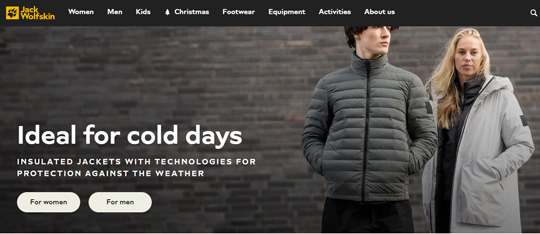
Jack Wolfskin’s official website
Jack Wolfskin, a well-known German brand established by Ulrich Dausien in 1981, has gained popularity in Europe due to its high-quality outdoor products.
Since 1997, the company has been headquartered in Idstein, Germany, and has expanded its market share significantly. Today, Jack Wolfskin offers a diverse range of outdoor equipment, including clothing, jackets, footwear, sleeping bags, backpacks, and tents.
Known for its commitment to sustainability and social responsibility, the brand has become a leading example of a responsible business in the outdoor apparel industry. Its products appeal to both those seeking quality casual wear and outdoor enthusiasts due to their style and performance.
Don’t miss:
9 Brands like Jack Wolfskin: Our Top Alternatives
9 German Jackets and Outdoor Clothing Brands that You’ll Love
Materials, Fabrics, and Production Process
Jack Wolfskin, a brand dedicated to minimizing its environmental impact, incorporates recycled materials such as recycled polyester into its outdoor products.
The company also utilizes a range of natural and synthetic materials for insulation, including RDS-certified Natural Down, Microguard (synthetic), PrimaLoft (synthetic), and Fibercloud (synthetic).
Additionally, Jack Wolfskin employs Texapore fabric technology, known for its windproof, breathable, waterproof, and snow-friendly properties, in its coats and sportswear, offering various styles and protection levels to accommodate diverse activities.
The video will be loaded from YouTube.com, a third party. If you play it, you accept their terms of service, and their use of cookies.
Read also:
Jack Wolfskin vs Helly Hansen: Which is Better?
Jack Wolfskin vs The North Face Outdoor Gear: A Comparison
Where is Jack Wolfskin’s outdoor gear made?
Products from Jack Wolfskin are manufactured in both European and Asian countries. Their production facilities are situated across Asia, including China, Vietnam, Bangladesh, South Korea, and other countries. In Europe, they manufacture in Germany, Slovenia, Turkey, and Italy. The sourcing of their raw materials spans across Europe, the USA, and Asia. (source)
Recommended Products
Jack Wolfskin Nebelhorn Women’s Down Hoody
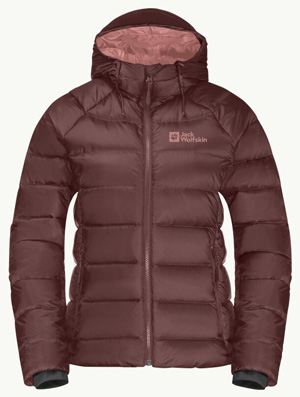
Image: jack-wolfskin.com
Check it out at Jack-Wolfskin.com
The Jack Wolfskin Nebelhorn Women’s Down Hoody is an advanced jacket designed to deliver superior protection in chilly conditions. Its outer fabric is crafted from recycled polyamide PERTEX QUANTUM, a water-repellent and windproof material, ensuring both environmental sustainability and weather resistance.
The insulation is made with high fill power, RDS-certified down, guaranteeing outstanding warmth. The fully adaptable hood provides excellent defense against snow and cold winds, and the snug-fitting internal cuffs enable easy glove wearing.
The jacket includes two zippered pockets for secure storage. This down hoody not only offers exceptional warmth but is also highly water-repellent and windproof, making it an excellent choice for cold weather. It’s also built with recycled materials and is bluesign-certified, showcasing the brand’s dedication to sustainability.
Jack Wolfskin Highland Trail 50+5 Women’s Trekking Pack
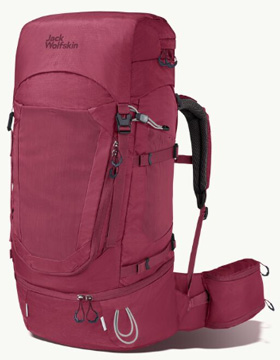
Image: jack-wolfskin.com
Check it out at Jack-Wolfskin.com
The Highland Trail 50+5 Backpack provides a tailored fit and features designed for women. Boasting a capacity of 50+5 liters, it offers ample space for extended journeys. The backpack incorporates a height-adjustable X-Transition back system, ensuring comfort, effective ventilation, and optimized load distribution for the carriage of heavy loads.
The main compartment facilitates flexible packing and quick access from both the top and front zippers. The long zipper on the lid pocket enables easy access to items, while a generously sized elasticated mesh pocket on the front serves as a convenient storage space for a jacket.
The waist belt has a dedicated pocket for a water bottle, and the backpack can accommodate a hydration bladder. It’s made using recycled materials and is designed with sustainability in mind, being PFC-free and bluesign certified.
Prices
A variety of items from Jack Wolfskin are affordable. This company offers numerous options for budget-conscious enthusiasts to purchase all their needed outdoor equipment. However, the brand’s pricing is not always accessible, with their jackets ranging from $60 to $500, backpacks from $50 to $400, and shoes from $60 to $230.
Are Jack Wolfskin products worth the price?
Their gear, in our opinion, is worth it for the price you pay. If you want top-notch equipment with a fair quality-to-price ratio, Jack Wolfskin is a good choice. They’re known for employing quality materials and the latest advancements in technology.
But, if you’re looking for more specialized outdoor gear, maybe you have to take a look at other more technical brands, like Norrøna for example, to have a more general idea of your available options.
Learn more: Why is Jack Wolfskin Expensive? Is It Good? Is It Worth It?
3. Which is Better? Norrøna or Jack Wolfskin?
Norrøna and Jack Wolfskin are both great. But for a more detailed answer, here are the main factors that we’d consider for the final decision:
Style: Norrøna has a more Scandinavian design with clean lines. But it also has more colorful designs. Jack Wolfskin has less vibrant colors and patterns in general.
Materials: Both brands use high-quality, technical fabrics designed to be durable, breathable, and water-resistant. Some examples include Gore-Tex, PrimaLoft, Polartec, and Jack Wolfskin’s Texapore.
Features: Jack Wolfskin clothing often has more pockets, straps, and zippers for functionality. Norrøna focuses more on simplicity and flexibility of movement.
Prices: Norrøna is more expensive due to the focus on niche and advanced snow sports like skiing and for its Scandinavian heritage style.
Activities: Norrøna is popular for advanced trekking, skiing, and snowboarding. Jack Wolfskin does well for more beginner-friendly activities like camping, hiking, and biking.
Sustainability: Both have sustainability programs and are transparent in their operations.
Warranty (At the time of writing): Norrøna offers a 5-year warranty on production and material defects. Jack Wolfskin has a limited two-year guarantee.
In the end, Norrøna is better for niche and expert-level outdoor activities in our opinion, as their gear’s durability and features justify the higher price. For general and casual outdoor activities, Jack Wolfskin offers more versatility with its lower prices.
Read next: 11 European Brands for Outdoor Enthusiasts: Our Top Picks
